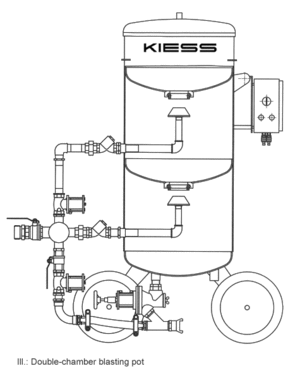7.3 Double-chamber blasting pot
In order to avoid frequent and time-consuming filling periods a system of a double-chamber blasting pot has been developed ensuring a permanent provision of the blasting unit with abrasive. Two pressure chambers being on top of each other enable continuous filling of the abrasive whereas the upper chamber acts as filing chamber and the bottom one as blasting pot. The volume of each chamber is 150 l. 2 mixing valves can be connected without any problems and by this 2 blasting units can also be connected which can even use jet nozzles with a nozzle diameter of up to 20 mm.
Double-chamber blasting pots can be both manually operated, as well as be delivered with remote control and filling control. In case of manual control an operator has to be present at the silo for operation. This operator has to depressurize the upper chamber by opening the air vent and when the abrasive is filled in he pressurizes it again. If the chamber is under pressure again the pressure-force ratio causes the closing cone of the lower chamber to open automatically and the abrasive flows into the lower chamber.
If filling is performed manually there is the risk that the bottom chamber is empty and that the abrasive to be filled in from the top enters the compressed-air flow too late; this would lead to the fact that the blaster at the nozzle only gets compressed air for a short time and no mixture of compressed-air/abrasive. This is avoided at double-chamber automatic pots because the time interval of the filling can be exactly adjusted according to the nozzle size.
The low mobility is a big disadvantage of this system. Comprehensive measures have to be taken to install the pot at a building site and to protect it from atmospheric influences like wind and rain. This will be particularly difficult in case of e.g. moving building site at bridges or tank depots where the location has to be changed several times.

Double-chamber blasting pot
Click to enlarge!



